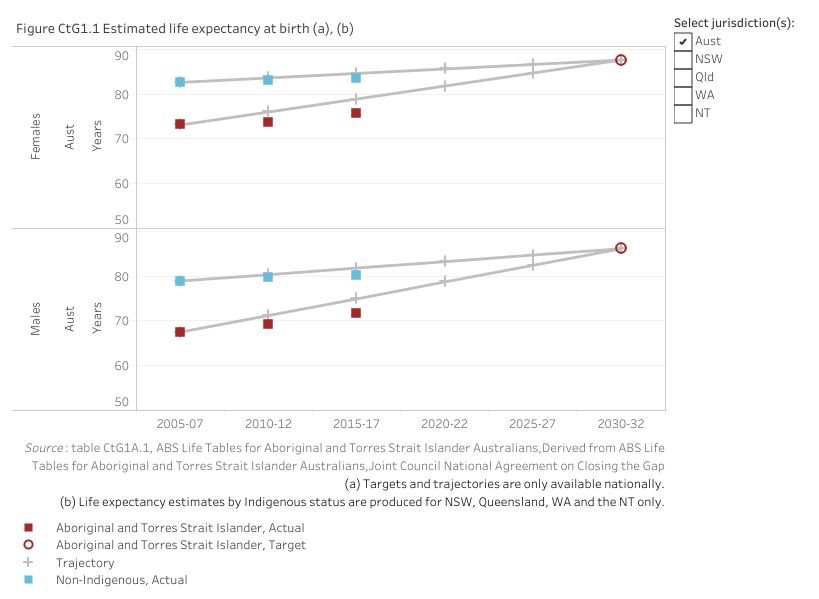TARGET 1
Close the Gap in life expectancy within a generation, by 2031
Dashboard snapshot: The data below are the most recent at the time of preparing the July 2021 report. Please go to the dashboard to access the current data.
Nationally, Aboriginal and Torres Strait Islander boys born in 2015–2017 are expected to live to 71.6 years and girls to 75.6 years, and non-Indigenous boys and girls to 80.2 years and 83.4 years respectively (figure CtG1.1). This results in a gap of 8.6 years for boys and 7.8 years for girls.
Nationally, based on the most recent year of data, the target is not on track to be met.

The assessment below reflects progress from the baseline year to the current year (ie improvement or otherwise in life expectancy). This differs to the national assessment against the trajectory (above), which compares the current year gaps to non-Indigenous males and females, to the gaps on the target trajectories at the same time period.
Target data specifications
Outcome: | Aboriginal and Torres Strait Islander people enjoy long and healthy lives. |
|---|---|
Target: | Close the Gap in life expectancy within a generation, by 2031. |
Indicator: | Life expectancy. |
Measure: | This measure is defined as: The average number of years that a newborn baby could expect to live, if they experienced the age/sex specific death rates that applied at their birth throughout their lifetimes. |
Target established: | National Agreement on Closing the Gap July 2020 |
Latest dashboard update: | 23 June 2021 |
Indicator type: | Target |
Interpretation of change: | A high or increasing life expectancy is desirable. An increase from the baseline year is an improvement. |
Data source(s): | Name: ABS Life Tables for Aboriginal and Torres Strait Islander Australians Frequency: Five-yearly Documentation (links): https://www.abs.gov.au/statistics/people/aboriginal-and-torres-strait-islander-peoples/life-tables-aboriginal-and-torres-strait-islander-australians/ |
Data provider: | Provider name: Australian Bureau of Statistics Provider area: Demography |
Baseline year: | 2006 (3-year average of 2005-2007) |
Target year: | 2031 (3-year average of 2030-2032) |
Disaggregations: | Selected states and territories and Australia, by Indigenous status, by sex. |
Computation: | Counting rules Direct estimation of the life expectancy gap at birth between Aboriginal and Torres Strait Islander and non-Indigenous people using the average number of deaths in the relevant three-year period and the estimated resident population (ERP) at the mid-point of that 3-year period, with adjustments for incomplete identification by Indigenous status. The Australian headline life expectancy estimates are calculated taking age-specific identification rates into account. The Australian total includes all states and territories (including Other Territories). Supporting calculations The difference in life expectancy estimates between Aboriginal and Torres Strait Islander and non-Indigenous people, and confidence intervals (upper and lower limits). Calculation of differences are based on unrounded estimates. |
Data quality considerations: | Aboriginal and Torres Strait Islander and non-Indigenous life tables are based on ERP (ABS 2017) (based on the Census of Population and Housing and the Census Post Enumeration Survey), death registration information provided by the State/Territory Registrars of Births, Deaths and Marriages, and the ABS Census Data Enhancement Indigenous Mortality Quality Study. Life expectancy estimates by Indigenous status are produced for NSW, Queensland, WA and the NT only. These estimates are calculated without taking age-specific identification rates into account. Aboriginal and Torres Strait Islander estimates of life expectancy are not produced for Victoria, SA, Tasmania and the ACT due to the small number of Aboriginal and Torres Strait Islander deaths reported in these jurisdictions. Caution is required when interpreting trends in life expectancy estimates, because of changes in Indigenous identification across data collection and over time, and variation across geographies and socioeconomic groups. |
Future reporting: | Additional disaggregations required for future reporting:
|
Supporting indicators
Driver
- All-cause mortality
- Leading causes of death
Infant mortality, child mortality, and five-yearly age groups - Potential avoidable mortality rates
- Prevalence rates of health risk factors
Smoking, alcohol and drug use, overweight and obese, dietary factors, physical activity - Rates of accessing/utilisation of health services
General Practitioner (GP) visits, health assessments (Medicare Benefit 715), chronic disease care items (Team Care arrangement and GP Management Plan)
Contextual information
- Hospitalisation rates by leading causes
- Discharge against medical advice
- Burden of disease from socioeconomic factors
